Plato and the cave allegory. An interpretation beginning with verbs of knowledge
Автор: Calabrese Claudio Csar
Журнал: Schole. Философское антиковедение и классическая традиция @classics-nsu-schole
Рубрика: Статьи
Статья в выпуске: 2 т.14, 2020 года.
Бесплатный доступ
In this paper we study the organization of the allegory of the cavern through the investigation of knowledge verbs. First, we briefly follow the interpretations of the allegory of the cave that we consider most significant and our perspective: all are valid provided that each does not deny the others. At our core we analyze the verbs of knowledge: how they relate to each other and what structure of knowledge they establish. In the conclusion, we affirm that the verbs do not present a vision of being as "what is", but as "what is being"; this means, with respect to the allegory, that the relation between being and intelligibility means a pathway of mutual equalization, which the prisoner of the cave goes through; nevertheless, the attempt to reach a comprehensive intelligence of the being requires one more step: to integrate the phenomena to the comprehension of the real thing.
Plato, republic, ancient epistemology, cave allegory, myth
Короткий адрес: https://sciup.org/147215879
IDR: 147215879
Список литературы Plato and the cave allegory. An interpretation beginning with verbs of knowledge
- Abensour, Miguel & Breaugh, Martin (2007) "Against the Sovereignty of Philosophy over Politics: Arendt's Reading of Plato's Cave Allegory," Social Research 74.4, 955-982.
- Brann, Eva (2011) The Music of the Republic. Essay on Socrates' Conversations and Plato's Writings. Philadelphia: Paul Dry Books.
- Calabrese, Claudio C. (2018) "Alegoría, mito y artes liberales en san Agustín, De ordine I. 8. 24," Graeco-Latina Brunensia 23.1, 21-34.
- Chantraine, Pierre (1977) Dictionnaire étymologique de la langue grecque: histoire des mots. Paris: Klincksieck.
- Clay, Diskin (1992) "Plato's first words," in: F. Dunn & T. Cole, eds. Beginnings in Classical Literature. Cambridge University Press, 113-129.
- Cornford, Francis M. (1941) The Republic of Plato. New York / London: Oxford University Press.
- Eliade, Mircea (1987) The Sacred and the Profane. The nature of the religion. New York / London: Harcourt.
- Grasso, Elsa (2013) "Images dans le texte: l'eikonologia platonicienne," Revue de Métaphysique et de Morale 4, 525-541.
- Esparza, Gustavo (2017) "La física simbolista y la literatura fantástica: una entreveración metodológica para la interpretación de 'Las fuerzas extrañas'," Revista de Letras 57.1, 71-86.
- Heidegger, Martin (1976) "Platons Lehere von der Wahrheit," Wegmarken (Gesamtausgabe, Band 9, Frankfurt am Main: Vittorio Klostermann) 203-238.
- Hofmann, Johann Baptist (1949) Etymologisches Wörterbuch des Griechischen. München:
- Verlag von R. Oldenburg. Huard, Roger L. (2006) Plato's Political Philosophy: The Cave. Washington DC: Algora Publishing.
- Humboldt, Wilhelm von (1836; 2003) Über die Verschiedenheit des menschlichen Sprachbaues und ihren auf die geistige Entwicklung des Menschengeschlechts. Weisbaden: Fourier Verlag.
- Humboldt, Wilhelm von (1999) On language. The diversity of human language structure and its influence in the mental development of the mankind. Cambridge / New York, Cambridge University Press.
- Jaeger, Werner (1973) PAIDEIA. Die Formung des griechischen Menschen. Berlin / New York: Walter de Gruyter.
- Kennedy, J. B. (2011) The Musical Structure of Plato's Dialogue. New York: Routledge.
- Killian, Jeremy (2012) "That Deceptive Line: Plato, Linear Perspective, Visual Perception, and Tragedy," The Journal of Aesthetic Education 46.2, 89-99.
- Lamberton, Robert (1986) Homer the theologian: Neoplatonist allegorical reading and the growth of the epic tradition. Berkeley / Los Angeles / London: University of California Press.
- Lewis, Clive Staples (2013) The Allegory of Love. A Study in Medieval Tradition. New York: Cambridge University Press.
- Liddell, Henry George R.; Robert Scott (1996) A Greek-English Lexicon, 9th ed. Oxford: Oxford University Press.
- Losin, Peter (1996) "Education and Plato's Parable of the Cave," The Journal of Education 178.3, 49-65.
- Nehamans, Alexander (2007) "Only in the contemplation of Beauty is human Life Worth Living, Plato, Symposium 211 d," European Journal of Philosophy 15.1, 1-18.
- Ricoeur, Paul (1975) La Métaphore Vive. Paris : Éditions du Seuil.
- Setaioli, Aldo (2004) "Interpretazioni stoiche ed epicuree in Servio e la tradizione dell'esegesi filosofica del mito e dei poeti a Roma (Comuto, Seneca, Filodemo)," InternationalJournal of the Classical Tradition 11.1, 3-46.
- Struck, Peter T. (2004) Birth of the Symbol. Ancient Readers at the Limits of Their Texts. Princeton, NJ / Oxford: Princeton University Press.
- Thompson, Iain D. (2005) Heidegger on Ontotheology: Technology and the Politics of Education. Cambridge: Cambridge University Press.
- Ustinova, Yulia (2009) Caves and the Ancient Greek Mind: Descending Underground in the Search for Ultimate Truth. Oxford: Oxford University Press.
- Wolfsdorf, David (2011) "Plato's Conception of Knowledge," The Classical World 105.1, 5775.
- Zovko, Marie Élise (2008) "The Way Up and the Way Back is the Same. The Ascent of Cognition in Plato's Analogies of the Sun, the Line and the Cave and the Path Intelligence Takes", in: John Dillon and Marie Élise Zovko, eds. Platonism and Forms of Intelligence. Berlin: Akademie Verlag, 313-341.


